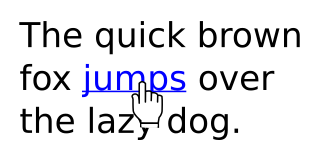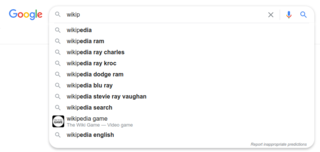This article needs to be updated.(June 2011) |
Pei-Yuan Wei (Chinese :魏培源; pinyin :Wèi Péiyuán) was a Taiwanese-American businessman who created ViolaWWW, the first popular graphical web browser.
This article needs to be updated.(June 2011) |
Pei-Yuan Wei (Chinese :魏培源; pinyin :Wèi Péiyuán) was a Taiwanese-American businessman who created ViolaWWW, the first popular graphical web browser.
Pei-Yuan Wei was born in Pingtung County, Taiwan. [1] He graduated from Berkeley High School [ citation needed ] in 1986. He received his bachelor's degree from the University of California, Berkeley, and was a member of the student club, the eXperimental Computing Facility (XCF).[ citation needed ]
In the 1990s, Wei was a founding employee of Global Network Navigator, one of the first Internet-based businesses. Later he worked for various Palm OS-related businesses. Since 2008, Perry has lived in both Taiwan and the US, devoting most of his time to taking care of his ill family member. [2]
Pei-Yuan Wei was at the center of a controversy over patents relating to embedded objects in a web browser, [3] [4] which revolves around whether his browser, ViolaWWW, had the capability to launch embedded objects, prior to the date a patent was filed by Michael David Doyle of Eolas, and the University of California. [3] If it did, it would constitute prior art, which may invalidate the patent issued to Eolas. [3] [4] If it did not, in addition to major financial penalties against such companies as Microsoft, the way the World Wide Web and the way browsers that surf it work may be forced to change. [3]
Eolas' claim was eventually found invalid by a Texas court. [5]

JavaScript, often abbreviated as JS, is a programming language and core technology of the Web, alongside HTML and CSS. 99% of websites use JavaScript on the client side for webpage behavior.

Java applets are small applications written in the Java programming language, or another programming language that compiles to Java bytecode, and delivered to users in the form of Java bytecode.
Konqueror is a free and open-source web browser and file manager that provides web access and file-viewer functionality for file systems. It forms a core part of the KDE Software Compilation. Developed by volunteers, Konqueror can run on most Unix-like operating systems. The KDE community licenses and distributes Konqueror under GNU GPL-2.0-or-later.
Multiple-image Network Graphics (MNG) is a graphics file format published in 2001 for animated images. Its specification is publicly documented and there are free software reference implementations available.

In computing, a hyperlink, or simply a link, is a digital reference to data that the user can follow or be guided to by clicking or tapping. A hyperlink points to a whole document or to a specific element within a document. Hypertext is text with hyperlinks. The text that is linked from is known as anchor text. A software system that is used for viewing and creating hypertext is a hypertext system, and to create a hyperlink is to hyperlink. A user following hyperlinks is said to navigate or browse the hypertext.

Eolas is a United States technology firm formed as a spin-off from the University of California, San Francisco (UCSF), in order to commercialize UCSF's patents for work done there by Eolas' co-founders, as part of the Visible Embryo Project. The company was founded in 1994 by Dr. Michael Doyle, Rachelle Tunik, David Martin, and Cheong Ang from the UCSF Center for Knowledge Management (CKM). The company was created at the request of UCSF, and was founded by the inventors of the university's patents.

ViolaWWW is a discontinued web browser, the first to support scripting and stylesheets for the World Wide Web (WWW). It was first released in 1991/1992 for Unix and acted as the recommended browser at CERN, where the WWW was invented, but eventually lost its position as most frequently used browser to Mosaic.
XCF, short for eXperimental Computing Facility, is the native image format of the GIMP image-editing program. It saves all of the data the program handles related to the image, including, among others, each layer, the current selection, channels, transparency, paths and guides.
Trident is a proprietary browser engine for the Microsoft Windows version of Internet Explorer, developed by Microsoft.
A web framework (WF) or web application framework (WAF) is a software framework that is designed to support the development of web applications including web services, web resources, and web APIs. Web frameworks provide a standard way to build and deploy web applications on the World Wide Web. Web frameworks aim to automate the overhead associated with common activities performed in web development. For example, many web frameworks provide libraries for database access, templating frameworks, and session management, and they often promote code reuse. Although they often target development of dynamic web sites, they are also applicable to static websites.
Founded in 1986, the eXperimental Computing Facility (XCF) is an undergraduate computing-interest organization at University of California, Berkeley. The "Experimental" description was given in contrast to the Open Computing Facility and the Computer Science Undergraduate Association, which support most of the general-interest computing desires of the campus. As such, the XCF stands as a focus for a small group of computer-scientists uniquely interested in computer science.

David Pope Anderson is an American research scientist at the Space Sciences Laboratory, at the University of California, Berkeley, and an adjunct professor of computer science at the University of Houston. Anderson leads the SETI@home, BOINC, Bossa, and Bolt software projects.
An image file format is a file format for a digital image. There are many formats that can be used, such as JPEG, PNG, and GIF. Most formats up until 2022 were for storing 2D images, not 3D ones. The data stored in an image file format may be compressed or uncompressed. If the data is compressed, it may be done so using lossy compression or lossless compression. For graphic design applications, vector formats are often used. Some image file formats support transparency.

A search engine is a software system that provides hyperlinks to web pages and other relevant information on the Web in response to a user's query. The user inputs a query within a web browser or a mobile app, and the search results are often a list of hyperlinks, accompanied by textual summaries and images. Users also have the option of limiting the search to a specific type of results, such as images, videos, or news.
An embedded database system is a database management system (DBMS) which is tightly integrated with an application software; it is embedded in the application. It is a broad technology category that includes:
The Handle System is the Corporation for National Research Initiatives's proprietary registry assigning persistent identifiers, or handles, to information resources, and for resolving "those handles into the information necessary to locate, access, and otherwise make use of the resources".

Snap! is a free block-based educational graphical programming language and online community. Snap allows students to explore, create, and remix interactive animations, games, stories, and more, while learning about mathematical and computational ideas. While inspired by Scratch, Snap! has many advanced features. The Snap! editor, and programs created in it, are web applications that run in the browser without requiring installation. It is built on top of Morphic.js, a Morphic GUI, written by Jens Mönig as 'middle layer' between Snap! itself and 'bare' JavaScript.
Events from the year 1992 in Taiwan, Republic of China. This year is numbered Minguo 81 according to the official Republic of China calendar.

DR-WebSpyder is a DOS web browser, mail client and operating system runtime environment that was developed by Caldera UK in 1997. It was based on the DR-DOS operating system and networking components from Novell as well as the Arachne web browser by Michal Polák of xChaos software. The system was designed to run on low-end desktop systems, but being able to boot and execute from disk as well as from ROM or network, it was also tailored for x86-based thin clients and embedded systems with or without disk drives. Using the web browser as its principal user interface, it could be also used for kiosk systems and set-top boxes. It was ported to Linux in 1999 under the name Embrowser and was renamed Embedix Browser in 2000.
The Visible Embryo Project (VEP) is a multi-institutional, multidisciplinary research project originally created in the early 1990s as a collaboration between the Developmental Anatomy Center at the National Museum of Health and Medicine and the Biomedical Visualization Laboratory (BVL) at the University of Illinois at Chicago, "to develop software strategies for the development of distributed biostructural databases using cutting-edge technologies for high-performance computing and communications (HPCC), and to implement these tools in the creation of a large-scale digital archive of multidimensional data on normal and abnormal human development." This project related to BVL's other research in the areas of health informatics, educational multimedia, and biomedical imaging science. Over the following decades, the list of VEP collaborators grew to include over a dozen universities, national laboratories, and companies around the world.